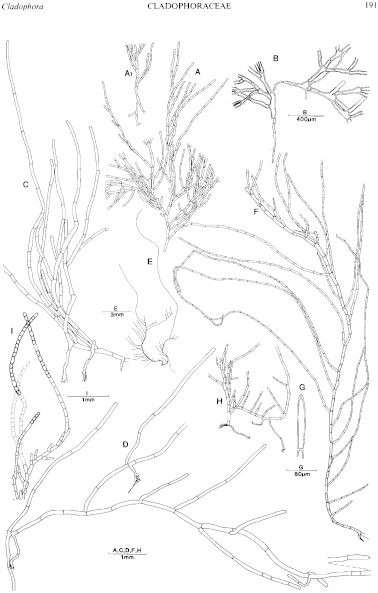|
|
|
|
|
|||||||||||
|
Electronic Flora of South Australia Species Fact Sheet
Phylum Chlorophyta – Order Cladophorales – Family Cladophoraceae
Selected citations: Womersley 1956: 361.
Synonyms
Cl. simpliciuscula Hooker & Harvey 1845: 295.
Non Cl. simpliciuscida Kützing 1843: 262 (see van den Hoek 1963: 113).
Cl. delicatula Montagne sensu Womersley 1950: 143; 1956: 360.
Cl. stuartii Harvey 1859b: 340; 1863, synop.: 60. De Toni 1889: 313. Womersley 1956: 359.
Thallus (Fig. 60D) pale to dark green, forming small mats or cushions or entangled curly masses, a few cm across and 1–4 (–10) cm high, composed of a basal tangle of branched, often curved, stolon-like filaments giving rise to erect filaments (Fig. 61E), occurring often among turf algae near low tide level, epilithic and epiphytic. Growth predominantly by frequent intercalary divisions producing filaments of relatively short cells; the erect filaments (Fig. 61F) in well developed plants extend 5–10 cm beyond the basal mat, and may be unbranched or bear mostly unilateral rows of branchlets or, in some cases, clusters of laterals from several adjacent cells; lateral branches mostly wide-angled (more than 45°), single or rarely two (exceptionally 3) from a parent cell with the basal wall usually steeply inclined but sometimes becoming almost horizontal; cell wall moderately thick; lower cells (Fig. 61H) frequently producing a descending rhizoid from their basal poles, attaching to the substrate or other filaments by coralloid holdfasts.
Apical cells (20–) 30–50 (–60) µm in diameter, L/B 2–6 (–8), tapering at least in their upper third and prominently so near their apices (Fig. 61G); mid cells 20–80 µm in diameter, L/B 2–5 (–8); lower cells 50–80 (–100) µm in diameter, L/B (1–) 2–6 (–7); ratio of lower cell to apical cell diameters 1–2; cell walls prominently lamellate, 4–6 µm thick above, 8–12 µm thick below.
Reproduction: Reproduction by zooids formed in terminal chains of swollen zooidangia (Fig. 611), each 60–100 µm in diameter and L/B 1–1.5 (–2).
Type from Hermite 1., Cape Horn, Fuegia (Hooker); in BM (ex K).
Selected specimens: Cape du Couedic, Kangaroo I., S. Aust., lower eulittoral (Womersley, 17.i.1950; ADU, A12674). Cape Lannes, S. Aust., on wave-washed mid eulittoral ledges (van den Hoek, 6.ix.1981; ADU, A52370). Stinky Bay, Nora Creina, S. Aust., mid eulittoral on wave-washed ledges (van den Hoek 81/9a, 5.ix.1981; ADU, A52691). Port MacDonnell, S. Aust., entangled with drift algae, mainly Corallina (van den Hoek 81/10, 3.ix.1981; ADU, A52667). Bridgewater Bay, Vic., upper sublittoral to low eulittoral turf (van den Hoek 81/8, 3.ix.1981; ADU, A52664). Bridgewater Bay, Vic., mid eulittoral wave-washed ledges, on Corallina (Womersley, 29.xii.1981; ADU, A52857). Apollo Bay, Vic., low eulittoral with Hormosira (van den Hoek 81/13, 2.ix.1981; ADU, A52651-"Marine Algae of southern Australia" No. 220; and amongst Xiphophora, ADU, A52662). Near Orford, Tas., in rock pool (Cribb 170. 3, 23.i.1952; ADU, A21035). Safety Cove, Port Arthur, Tas., lower and mid eulittoral (Skinner, 21.ii.1978; ADU, A49240); lower eulittoral (Gordon, 13.i.1966; ADU, A30024).
Distribution: Cape Horn, Falkland Is, New Zealand.
In southern Australia, from Cape du Couedic, Kangaroo I., S. Aust. to Kiama, N.S.W. and south-east Tasmania. Cl. subsimplex grows on mid eulittoral wave-washed ledges, in rock pools, and down into the uppermost sublittoral of wave-exposed shores in the algal turf. The colour is mostly medium to dark green, but in summer plants may be bleached to pale green.
Taxonomic notes: Cl. subsimplex is a distinctive species, resembling Cl. coelothrix in habit (though smaller) and in the presence of frequent rhizoids, but differing in dimensions, in having much shorter cells, in the tapering apical cells, and in the terminal chains of short zooidangia. Specimens with long, curved, unbranched or little branched filaments may resemble Rhizoclonium riparium in habit but the filaments are much greater in diameter.
The type of Cl. stuartii in TCD represents the long, erect branches without the entangled base, but agrees well with Cl. subsimplex.
References:
DE TONI, G.B. (1889–1924). Sylloge Algarum omnium hucusque Cognitarium. Vols 1–6. (Padua.)
HARVEY, W.H. (1859b). Algae. In J.D. Hooker, the Botany of the Antarctic Voyage. Part III. Flora Tasmaniae. Vol. 2, pp.282–343, Plates 185–196.
HARVEY, W.H. (1863). Phycologia Australica. Vol. 5, Plates 241–300, synop., pp. 1–73. (Reeve: London.)
HOOKER, J.D. & HARVEY, W.H. (1845). Algae Antarcticae. Lond. J. Bot. 4, 249–276, 293–298.
KÜTZING, F.T. (1843). Phycologia generalis. (Leipzig.)
KÜTZING, F.T. (1849). Species Algarum. (Leipzig.)
WOMERSLEY, H.B.S. (1950). The marine algae of Kangaroo Island. III. List of species 1. Trans R. Soc. S. Aust. 73, 137–197.
WOMERSLEY, H.B.S. (1956). A critical survey of the marine algae of southern Australia. I. Chlorophyta. Aust. J. mar. freshw. Res. 7, 343–383.
The Marine Benthic Flora of Southern Australia Part I complete list of references.
Publication:
Womersley, H.B.S. (31 May, 1984)
The Marine Benthic Flora of Southern Australia
Part I
©Board of the Botanic Gardens and State Herbarium, Government of South Australia
Illustration in Womersley Part I, 1984: FIGS 60D, 61 E–I.

Figure 61 enlarge
Fig. 61. A,B. Cladophora aegagropiloidea (Type, ADU, Al2607). A. Upper branch system. A'. Part of thallus showing reversion of polarity. B. Lower thallus. C,D. Cladophora coelothrix (ADU, A22470). Branch systems with rhizoids. E–I. Cladophora subsimplex (E–H, ADU, A30024; I, ADU, A52662). E. Branching pattern. F. Upper branch system. G. Apical cell. H. Lower branches with rhizoids. I. Fertile upper branches.

|
Email Contact: State Herbarium of South Australia |

|